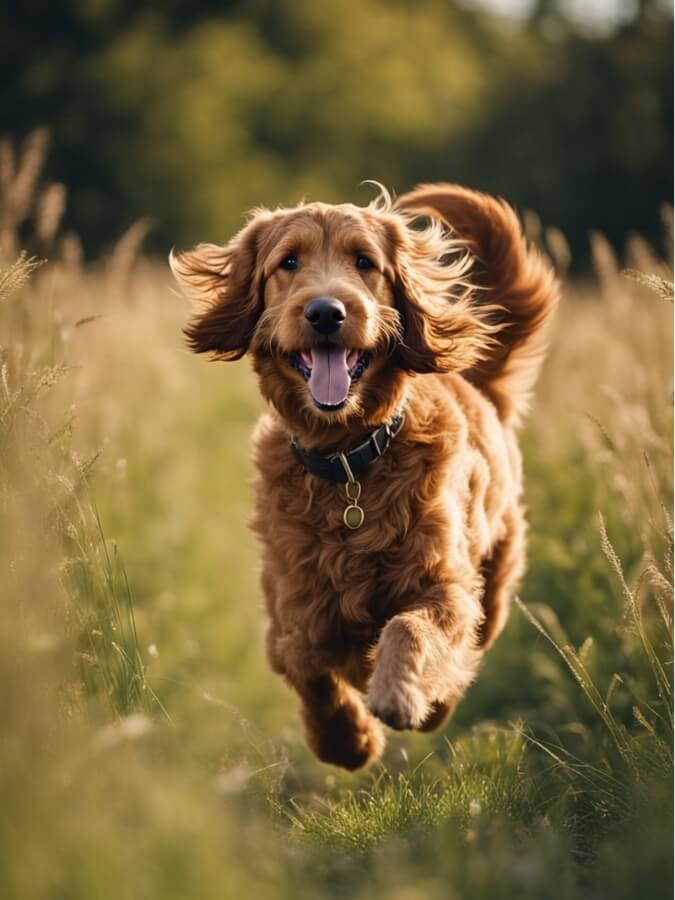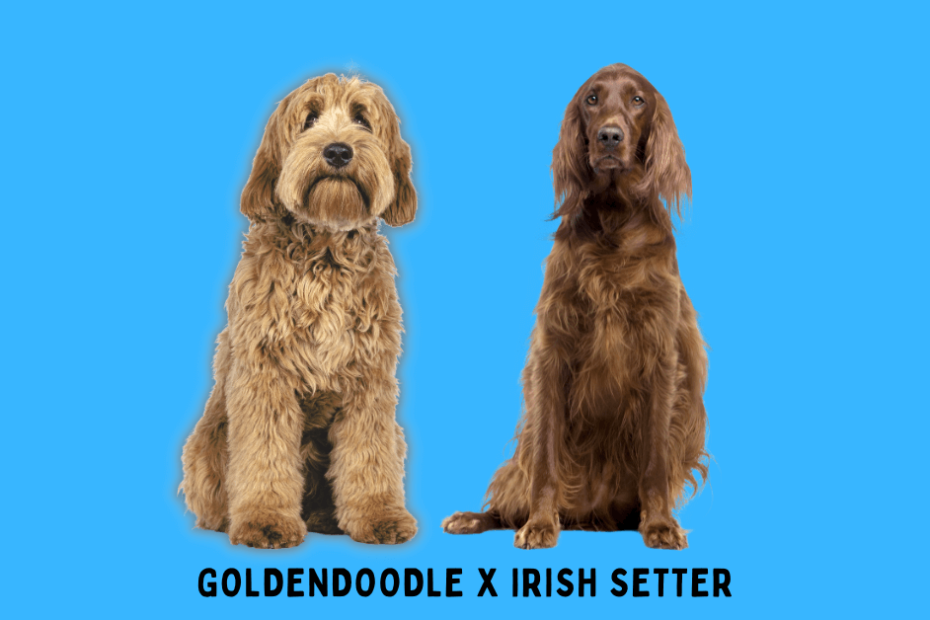The Goldendoodle-Irish Setter mix, also known as the Golden Irish Doodle, is a unique blend of two beloved breeds.
Combining the smart and friendly Goldendoodle with the energetic and beautiful Irish Setter, this mix raises many questions.
Is it the best of both worlds, or a complicated combination?
In this article, we’ll dive into the characteristics of the Golden Irish Doodle, exploring what makes this crossbreed an interesting topic among dog enthusiasts.

Breed Summary
The Goldendoodle-Irish Setter mix is a hybrid breed that combines the friendly and affectionate personality of the Goldendoodle with the energetic and playful nature of the Irish Setter.
This breed is known for its intelligence, loyalty, and trainability, making it an excellent choice for families with children or active individuals looking for a companion.
The Goldendoodle-Irish Setter mix typically has a wavy or curly coat that can come in a variety of colors, including red, apricot, cream, and gold.
This breed is also known for its hypoallergenic qualities, making it a great choice for individuals with allergies.
Due to their high energy levels, Goldendoodle-Irish Setter mixes require plenty of exercise and mental stimulation to stay happy and healthy.
They enjoy long walks, runs, and playing games such as fetch or frisbee.
This breed also thrives on human interaction and loves to be a part of the family, so they do best in homes where they can receive plenty of attention and affection.

Histories of the Parent Breeds
The Goldendoodle-Irish Setter mix is a crossbreed between a Goldendoodle and an Irish Setter.
To understand the characteristics of this hybrid breed, it is essential to look into the histories of the parent breeds.
Goldendoodle
The Goldendoodle is a crossbreed between a Golden Retriever and a Poodle.
This breed was first developed in the United States in the 1990s.
The breeders aimed to create a dog that had the intelligence, low-shedding coat, and friendly nature of the Golden Retriever, and the hypoallergenic coat of the Poodle.
The Goldendoodle quickly gained popularity due to its friendly nature, intelligence, and low-shedding coat.
Irish Setter
The Irish Setter is a breed that originated in Ireland in the 18th century.
This breed was developed for hunting and retrieving game birds.
The Irish Setter quickly became popular in the United States due to its elegant looks and friendly nature. The breed is known for its red coat, which comes in different shades of red.
The Irish Setter is an active and energetic breed that requires a lot of exercise.
They are known for their friendly nature and make great family pets.
They are also used as therapy dogs due to their calm and gentle temperament.
The Goldendoodle-Irish Setter mix is a crossbreed that combines the best traits of both parent breeds.
The hybrid breed is known for its friendly nature, intelligence, low-shedding coat, and elegant looks.
Coat
The Goldendoodle-Irish Setter mix has a coat that can vary depending on the dominant genes inherited from each parent.
Generally, this mix has a wavy or curly coat that can range from medium to long in length.
The coat can be solid red, gold, or a combination of both colors.

Due to their parent breeds, Goldendoodle-Irish Setter mixes are often hypoallergenic and shed less than other breeds.
However, it is important to note that no dog breed is completely hypoallergenic, and individual allergies may vary.
To keep their coat healthy and shiny, regular grooming is necessary.
Brushing their coat at least once a week will help prevent matting and tangling.
Regular baths and trimming may also be necessary to maintain their coat’s appearance.
Coat Colors
The Goldendoodle-Irish Setter mix can inherit a variety of coat colors from its parents.
The Goldendoodle parent can pass on colors such as cream, apricot, red, and chocolate.
Meanwhile, the Irish Setter parent can contribute its signature rich red coat color.
As a result, the Goldendoodle-Irish Setter mix can have a coat color that ranges from light cream to deep red.
In addition to solid colors, this mix can also have a combination of colors such as white markings on the chest, feet, and face.
Some Goldendoodle-Irish Setter mixes can also have a parti-colored coat, which is a coat with two or more colors that are clearly defined and separated.
It’s important to note that coat colors can vary even within the same litter, as the genes responsible for coat color inheritance can be complex.
Therefore, it’s best to appreciate the unique coat color of each Goldendoodle-Irish Setter mix.
Coat Patterns
One of the most striking features of the Goldendoodle-Irish Setter mix is their unique coat patterns.
As a crossbreed, their coat can vary greatly depending on which parent they take after more.
Both Goldendoodles and Irish Setters are known for their curly, wavy coats, which can come in a range of colors from cream to red.
The Goldendoodle-Irish Setter mix can inherit this same curly or wavy coat, but with a wider range of colors due to the Irish Setter’s influence.
Some common coat patterns for this mix include solid colors, parti-colors (two or more distinct colors), and even merle (irregular blotches of fur).
The merle pattern is especially unique and eye-catching, and is caused by a specific gene that both Goldendoodles and Irish Setters can carry.
It’s important to note that the coat of a Goldendoodle-Irish Setter mix will require regular grooming to prevent matting and tangling. Regular brushing and trimming will help keep their coat healthy and shiny, and will also reduce shedding.
Height
The Goldendoodle-Irish Setter mix is a medium to large-sized dog breed.
As with any mixed breed, the size of the dog can vary depending on the parents’ size and weight.
Generally, these dogs stand between 22 and 27 inches tall at the shoulder.
It’s important to note that the height and weight of a Goldendoodle-Irish Setter mix can also be influenced by factors such as diet, exercise, and overall health.
Weight
The Goldendoodle-Irish Setter mix is a medium to large-sized dog breed.
As with any mixed breed, their weight can vary depending on the size of their parents.
The Irish Setter typically weighs between 60 to 70 pounds for males and 53 to 64 pounds for females.
On the other hand, the Goldendoodle breed can weigh anywhere between 45 to 90 pounds, depending on their size and type.
Therefore, the weight of a Goldendoodle-Irish Setter mix can range from 45 to 90 pounds.
Temperament
The Goldendoodle-Irish Setter mix is an energetic and affectionate dog that loves to be around people.
They are intelligent and eager to please, making them easy to train. This breed is known for its friendly and outgoing personality, making them great family pets.

Goldendoodle-Irish Setter mixes are known for their playful nature and love of outdoor activities.
They enjoy playing fetch and going for long walks or runs. They are also great with children and other pets, making them a great addition to any household.
This breed is known for being loyal and protective of their family, making them great watchdogs.
They are also known for being gentle and patient, making them great with children.
Health Issues
Goldendoodle-Irish Setter mixes are generally healthy dogs, but like all breeds, they can be prone to certain health issues.
It’s important to be aware of these issues so that you can take steps to prevent or treat them.
One common health issue that can affect Goldendoodle-Irish Setter mixes is hip dysplasia.
This is a condition where the hip joint doesn’t form properly, which can lead to arthritis and pain.
To help prevent hip dysplasia, it’s important to keep your dog at a healthy weight and to avoid activities that put too much stress on their joints.
Another health issue that can affect Goldendoodle-Irish Setter mixes is ear infections.
This is because both breeds are prone to ear infections, so their offspring may be as well.
To prevent ear infections, it’s important to keep your dog’s ears clean and dry, and to take them to the vet if you notice any signs of infection.
Goldendoodle-Irish Setter mixes can also be prone to allergies, which can cause skin irritation, itching, and other symptoms.
To help prevent allergies, it’s important to feed your dog a high-quality diet and to avoid exposure to common allergens like pollen and dust.
Check out these doggos!





